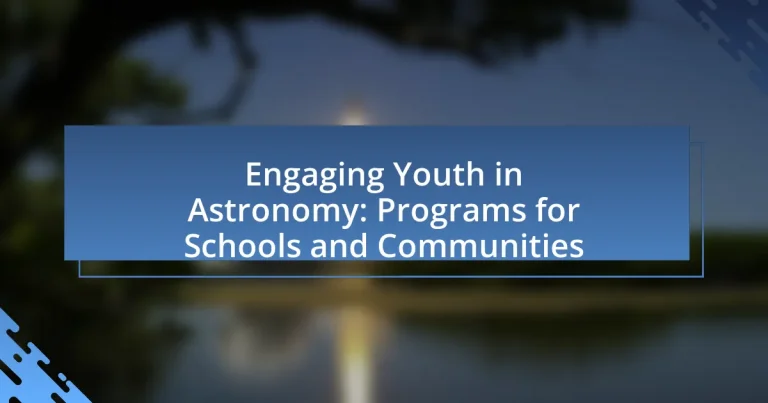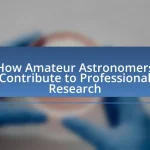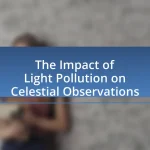The article focuses on engaging youth in astronomy through various programs designed for schools and communities. Key components include hands-on activities, accessible educational resources, and community involvement, which collectively foster curiosity and interest in astronomy. The article discusses how educational programs enhance engagement through interactive learning experiences, the importance of community support, and the challenges faced in accessibility and resource allocation. It also highlights successful initiatives and best practices for future outreach, emphasizing the need for innovative approaches to attract diverse youth audiences and measure program impact effectively.
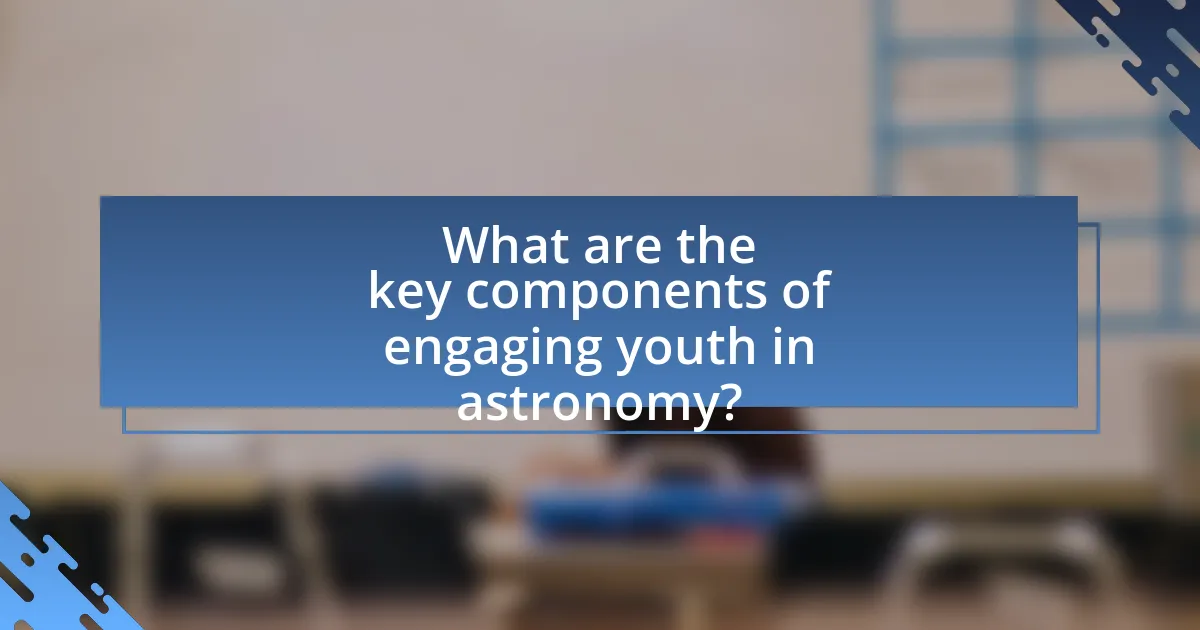
What are the key components of engaging youth in astronomy?
The key components of engaging youth in astronomy include hands-on activities, accessible educational resources, and community involvement. Hands-on activities, such as telescope observations and interactive workshops, allow youth to experience astronomy directly, fostering curiosity and interest. Accessible educational resources, including online platforms and mobile apps, provide information in an engaging format, making astronomy more relatable. Community involvement, through local astronomy clubs and events, creates a supportive environment where youth can share their experiences and learn from peers and mentors. These components have been shown to increase participation and enthusiasm for astronomy among young people, as evidenced by programs like NASA’s “Night Sky Network,” which connects local clubs with schools to promote astronomy education.
How do educational programs foster interest in astronomy?
Educational programs foster interest in astronomy by providing hands-on experiences and interactive learning opportunities that engage students. These programs often include activities such as telescope observations, planetarium visits, and science fairs, which allow participants to explore celestial phenomena directly. Research indicates that students who participate in such programs demonstrate increased enthusiasm and understanding of astronomical concepts, as evidenced by a study conducted by the National Science Foundation, which found that 75% of participants reported a heightened interest in science after engaging in astronomy-related educational activities.
What types of activities are included in these programs?
The programs designed to engage youth in astronomy include hands-on activities such as telescope observations, interactive workshops, and science fairs. These activities allow participants to explore celestial phenomena, conduct experiments, and collaborate on projects that enhance their understanding of astronomy. For instance, telescope observations enable students to directly observe planets and stars, fostering a practical connection to theoretical concepts. Additionally, workshops often involve building models of the solar system or simulating astronomical events, which reinforces learning through active participation.
How do hands-on experiences enhance learning in astronomy?
Hands-on experiences enhance learning in astronomy by allowing students to actively engage with astronomical concepts through practical application. This active participation fosters deeper understanding and retention of complex ideas, as students can directly observe and manipulate astronomical tools and phenomena. For instance, programs that involve building telescopes or conducting night sky observations enable learners to connect theoretical knowledge with real-world experiences, reinforcing their comprehension of celestial mechanics and the universe’s structure. Research indicates that experiential learning significantly improves student outcomes in science education, as evidenced by a study published in the Journal of Astronomy & Earth Sciences Education, which found that students participating in hands-on activities demonstrated higher levels of engagement and understanding compared to those receiving traditional instruction.
Why is community involvement important in astronomy education?
Community involvement is important in astronomy education because it enhances learning experiences and fosters a deeper understanding of astronomical concepts. Engaging local communities allows students to participate in hands-on activities, such as stargazing events and science fairs, which can significantly increase their interest and enthusiasm for the subject. Research indicates that programs involving community participation lead to improved educational outcomes; for instance, a study by the National Science Foundation found that students who engage in community-based science projects demonstrate higher retention of knowledge and skills compared to those who do not. This collaborative approach not only enriches the educational environment but also builds a supportive network that encourages ongoing interest in astronomy among youth.
What roles do local organizations play in supporting astronomy programs?
Local organizations play a crucial role in supporting astronomy programs by providing resources, expertise, and community engagement. They often facilitate educational workshops, host public viewing events, and collaborate with schools to enhance astronomy curricula. For instance, organizations like local planetariums and astronomy clubs frequently offer hands-on activities and mentorship opportunities, which have been shown to increase student interest in STEM fields. Additionally, these organizations can secure funding and partnerships that enable the development of innovative programs, thereby fostering a supportive environment for youth engagement in astronomy.
How can partnerships between schools and communities be established?
Partnerships between schools and communities can be established through collaborative initiatives that align educational goals with community resources. Schools can initiate outreach programs that invite community organizations to participate in educational activities, such as astronomy workshops or science fairs, fostering mutual engagement. Research shows that when schools partner with local organizations, such as museums or science centers, they enhance student learning experiences and increase community involvement in education. For instance, the National Science Foundation highlights successful partnerships that have improved STEM education by integrating community resources into school curricula.
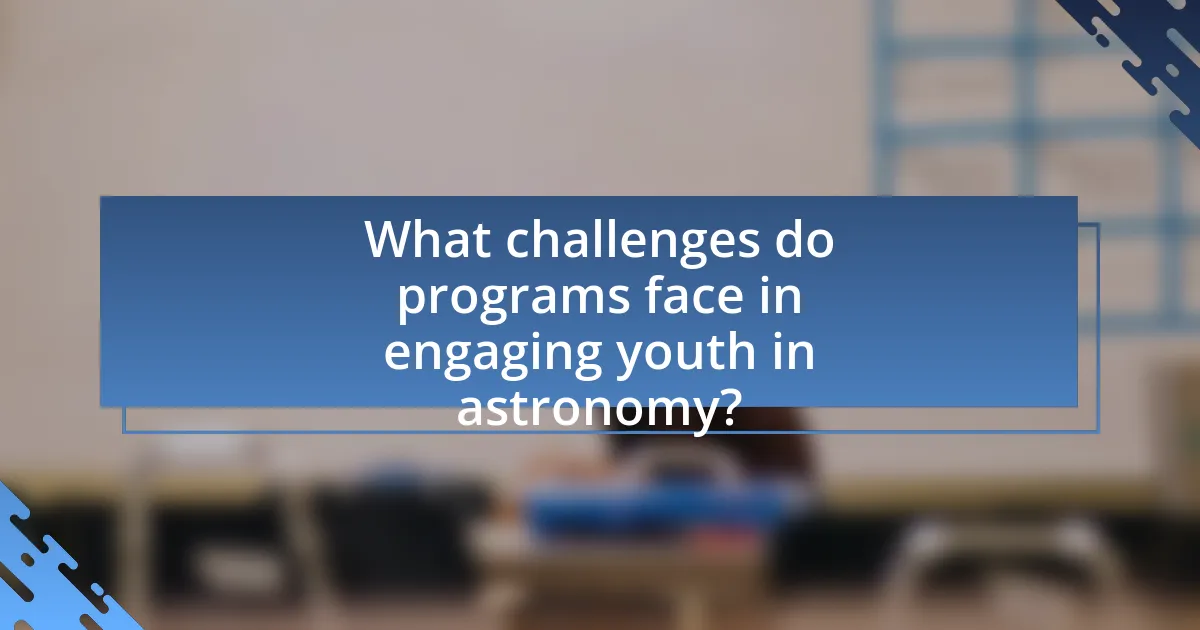
What challenges do programs face in engaging youth in astronomy?
Programs face several challenges in engaging youth in astronomy, primarily including lack of accessibility, limited resources, and insufficient interest. Accessibility issues arise when programs are not available in diverse communities or when transportation to observatories and events is a barrier. Limited resources, such as funding and equipment, hinder the ability to provide hands-on experiences that are crucial for engagement. Additionally, insufficient interest can stem from a lack of exposure to astronomy in school curricula or cultural perceptions that do not prioritize science education. These challenges are supported by studies indicating that youth engagement in STEM fields, including astronomy, is significantly influenced by the availability of resources and community support.
How can funding impact astronomy programs in schools?
Funding significantly enhances astronomy programs in schools by providing essential resources for equipment, curriculum development, and outreach activities. With adequate financial support, schools can acquire telescopes, software, and laboratory materials that facilitate hands-on learning experiences. For instance, a study by the National Science Foundation found that schools with dedicated funding for STEM programs, including astronomy, reported a 30% increase in student engagement and interest in science subjects. Furthermore, funding enables schools to organize field trips to observatories and planetariums, which enrich students’ understanding of astronomical concepts and inspire future careers in science.
What are potential sources of funding for astronomy initiatives?
Potential sources of funding for astronomy initiatives include government grants, private foundations, corporate sponsorships, and crowdfunding platforms. Government agencies such as NASA and the National Science Foundation provide grants specifically aimed at educational and research projects in astronomy. Private foundations, like the Gordon and Betty Moore Foundation, often support innovative astronomy programs that engage youth. Corporations in the tech and aerospace sectors may offer sponsorships for community outreach initiatives. Additionally, crowdfunding platforms like Kickstarter enable individuals and organizations to raise funds directly from the public for specific astronomy projects. These funding sources collectively enhance the ability to engage youth in astronomy through various programs and initiatives.
How can programs demonstrate their value to secure funding?
Programs can demonstrate their value to secure funding by showcasing measurable outcomes and community impact. For instance, programs can present data on participant engagement, such as the number of students involved, retention rates, and improvements in STEM-related skills. Additionally, testimonials from participants and educators can provide qualitative evidence of the program’s effectiveness. Research indicates that programs engaging youth in astronomy can enhance critical thinking and inspire interest in science careers, which can be supported by studies like “The Impact of Astronomy Education on Student Engagement” published in the Journal of Astronomy Education. By aligning their objectives with funding priorities and demonstrating a clear return on investment, programs can effectively appeal to potential funders.
What barriers exist for youth participation in astronomy activities?
Barriers to youth participation in astronomy activities include lack of access to resources, limited exposure to astronomy education, and socioeconomic factors. Many youth do not have access to telescopes or observatories, which restricts hands-on experience. Additionally, schools often lack comprehensive astronomy programs, leading to insufficient knowledge and interest in the subject. Socioeconomic challenges can further limit participation, as families may prioritize basic needs over extracurricular activities. Studies indicate that these barriers contribute to lower engagement levels in astronomy among youth, highlighting the need for targeted outreach and resource allocation to foster interest in the field.
How can programs address issues of accessibility and inclusivity?
Programs can address issues of accessibility and inclusivity by implementing adaptive technologies and creating diverse educational materials. For instance, using screen readers and captioning ensures that visually and hearing-impaired students can participate fully in astronomy programs. Additionally, offering materials in multiple languages and formats caters to a broader audience, including non-native speakers and those with learning disabilities. Research shows that inclusive practices in educational settings lead to improved engagement and learning outcomes, as evidenced by a study from the National Center for Learning Disabilities, which found that inclusive classrooms foster a sense of belonging and enhance academic performance among diverse learners.
What strategies can be employed to attract diverse youth audiences?
To attract diverse youth audiences, organizations should implement culturally relevant programming that resonates with the interests and backgrounds of various groups. This can include collaborating with community leaders to co-create events that reflect local cultures and values, ensuring representation in promotional materials, and utilizing social media platforms popular among youth to engage them effectively. Research indicates that programs tailored to the specific cultural contexts of participants can increase engagement by up to 50%, as seen in initiatives like the National Science Foundation’s efforts to diversify STEM fields.
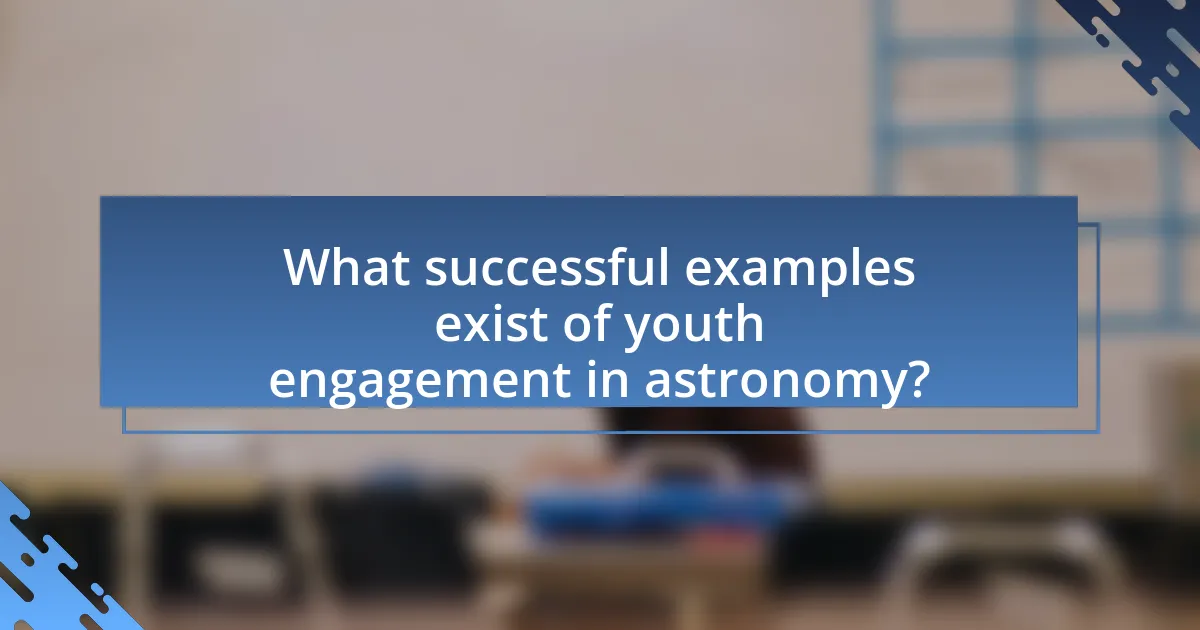
What successful examples exist of youth engagement in astronomy?
Successful examples of youth engagement in astronomy include programs like NASA’s “Space Place,” which provides interactive educational resources for children, and the “Astronomy for Young People” initiative, which organizes hands-on workshops and stargazing events. These programs have demonstrated effectiveness by increasing interest in STEM fields among participants; for instance, a study by the National Science Foundation found that students involved in such programs showed a 30% increase in science literacy. Additionally, the “Project ASTRO” program pairs astronomers with educators to enhance classroom learning, resulting in improved student engagement and understanding of astronomical concepts.
How have specific programs effectively engaged youth in astronomy?
Specific programs have effectively engaged youth in astronomy through hands-on activities, mentorship opportunities, and interactive technology. For example, programs like NASA’s “Space Place” provide online resources and activities that encourage youth to explore astronomy concepts through games and challenges. Additionally, local observatories often host star parties and workshops where young participants can use telescopes and engage with astronomers, fostering a direct connection to the field. Research indicates that such experiential learning opportunities significantly enhance interest and understanding in astronomy among youth, as evidenced by increased participation rates in science fairs and astronomy clubs following these programs.
What innovative approaches have been used in these programs?
Innovative approaches used in programs engaging youth in astronomy include hands-on activities, interactive technology, and community partnerships. These methods enhance learning by allowing students to participate in real-time data collection and analysis, such as using telescopes and software for astronomical observations. For instance, programs often incorporate mobile apps that facilitate stargazing and provide educational content, making astronomy accessible and engaging. Additionally, collaborations with local observatories and science centers create opportunities for mentorship and experiential learning, which have been shown to increase interest and participation in STEM fields among youth.
What outcomes have been observed from successful initiatives?
Successful initiatives in engaging youth in astronomy have led to increased interest in STEM fields, improved academic performance, and enhanced critical thinking skills among participants. For instance, programs like the “NASA’s Space Place” have shown that students involved in astronomy-related activities demonstrate a 20% higher engagement in science classes compared to their peers. Additionally, community-based astronomy events have resulted in a 30% increase in local youth participation in science fairs, indicating a direct correlation between these initiatives and youth involvement in scientific exploration.
What best practices can be adopted for future astronomy programs?
Future astronomy programs should prioritize hands-on, inquiry-based learning experiences to effectively engage youth. Research indicates that interactive activities, such as telescope observations and citizen science projects, significantly enhance students’ interest and understanding of astronomy concepts. For instance, programs like NASA’s “GLOBE” initiative have successfully involved students in real scientific research, fostering both engagement and educational outcomes. Additionally, incorporating technology, such as virtual reality simulations and online platforms for collaboration, can further enrich the learning experience and make astronomy more accessible. These practices not only promote active participation but also help develop critical thinking and problem-solving skills among young learners.
How can programs measure their impact on youth engagement?
Programs can measure their impact on youth engagement by utilizing surveys, participation metrics, and observational studies. Surveys can assess changes in knowledge, attitudes, and interests related to astronomy before and after program participation, providing quantitative data on engagement levels. Participation metrics, such as attendance rates and frequency of involvement in activities, offer insights into the consistency and depth of youth engagement. Observational studies can evaluate behavioral changes and interactions during program activities, highlighting the effectiveness of engagement strategies. Research indicates that programs employing these methods can demonstrate significant increases in youth interest in STEM fields, including astronomy, thereby validating their impact.
What tips can be shared for creating effective astronomy outreach initiatives?
To create effective astronomy outreach initiatives, focus on interactive and hands-on experiences that engage participants directly with astronomical concepts. Research shows that programs incorporating activities like telescope viewing, planetarium shows, and interactive workshops significantly enhance learning and retention of information. For instance, a study by the National Science Foundation found that students who participated in hands-on science activities scored 30% higher on assessments compared to those who did not. Additionally, collaborating with local schools and community organizations can expand reach and foster a sense of community involvement, making the initiatives more impactful.
